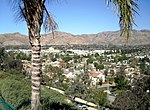Sayre Fire

The Sayre Fire, also known as the Sylmar Fire, was a November 2008 wildfire that resulted in the loss of 489 residences in Los Angeles, California, United States, the "worst loss of homes due to fire" in the city's history. The fire was first reported at 10:29 p.m. PDT on November 14, 2008, in the Sylmar section of Los Angeles. As of November 20, 2008, the fire was 100% contained, had burned 11,262 acres (46 km2) and destroyed more than 600 structures (480 mobile homes, nine single-family homes, 104 outbuildings and 10 commercial buildings). The number of homes lost in the Sayre fire exceeded the prior record set in 1961 by the Bel Air Fire which claimed 484 homes. There were no fatalities, just minor injuries to five firefighters and one civilian.
Excerpt from the Wikipedia article Sayre Fire (License: CC BY-SA 3.0, Authors, Images).Sayre Fire
Sycamore, Los Angeles Sylmar Neighborhood Council District
Geographical coordinates (GPS) Address Nearby Places Show on map
Geographical coordinates (GPS)
| Latitude | Longitude |
|---|---|
| N 34.333333333333 ° | E -118.46666666667 ° |
Address
MRCA Open Space
Sycamore
91342 Los Angeles, Sylmar Neighborhood Council District
California, United States
Open on Google Maps




